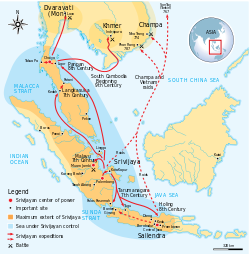Srivijaya
|
|||||||||||||||||||||||||||||||||||||
| This article is part of the History of Indonesia series |
|---|
 |
| See also: |
| Prehistory |
| Early kingdoms |
| Tarumanagara (358-669) |
| Srivijaya (7th to 13th centuries) |
| Sailendra (8th to 9th centuries) |
| Sunda Kingdom (669-1579) |
| Medang Kingdom (752–1045) |
| Kediri (1045–1221) |
| Singhasari (1222–1292) |
| Majapahit (1293–1500) |
| The rise of Muslim states |
| The spread of Islam (1200–1600) |
| Sultanate of Ternate (1257–....) |
| Malacca Sultanate (1400–1511) |
| Sultanate of Demak (1475–1548) |
| Aceh Sultanate (1496–1903) |
| Sultanate of Banten (1526–1813) |
| Mataram Sultanate (1500s to 1700s) |
| European colonialism |
| The Portuguese (1512–1850) |
| Dutch East India Co. (1602–1800) |
| Dutch East Indies (1800–1942) |
| The emergence of Indonesia |
| National awakening (1899–1942) |
| Japanese occupation (1942–1945) |
| National revolution (1945–1950) |
| Independent Indonesia |
| Liberal democracy (1950–1957) |
| Guided Democracy (1957–1965) |
| Start of the New Order (1965–1966) |
| The New Order (1966–1998) |
| Reformasi era (1998–present) |
| Edit this template |
Srivijaya or Sriwijaya was a powerful ancient Malay empire based on the island of Sumatra, modern day Indonesia, which influenced much of Southeast Asia.[1] The earliest solid proof of its existence dates from the 7th century; a Chinese monk, I-Tsing, wrote that he visited Srivijaya in 671 for 6 months.[2][3] The first inscription in which the name Srivijaya appears also dates from the 7th century, namely the Kedukan Bukit Inscription around Palembang in Sumatra, dated 683.[4] The kingdom ceased to exist in the 13th century due to various factors, including the expansion of the Javanese Majapahit empire.[1] Srivijaya was an important center for Buddhist expansion in the 8th to 12th centuries. In Sanskrit, sri (श्री) means "shining" or "radiant" and vijaya (विजय) means "victory" or "excellence".[5]
After Srivijaya fell, it was largely forgotten and so historians had never considered that a large united kingdom could have been present in Southeast Asia. The existence of Srivijaya was only formally suspected in 1918 when French historian George Coedès of the École française d'Extrême-Orient postulated the existence of the empire.[5] By 1993, Pierre-Yves Manguin proved that the centre of Srivijaya was along the Musi River between Bukit Seguntang and Sabokingking (situated in what is now the province of South Sumatra, Indonesia).[5]
Contents |
Historiography
There was no continuous knowledge of Srivijaya in Indonesian histories; its forgotten past has been recreated by foreign scholars. No modern Indonesians, not even those of the Palembang area around which the kingdom was based, had heard of Srivijaya until the 1920s, when French scholar George Coedès published his discoveries and interpretations in Dutch and Indonesian-language newspapers.[6] Coedès noted that the Chinese references to "Sanfoqi", previously read as "Sribhoja", and the inscriptions in Old Malay refer to the same empire.[7]
Srivijaya became a symbol of early Sumatran greatness, and a great empire to balance Java's Majapahit in the east. In the twentieth century, both empires were referred to by nationalist intellectuals to argue for an Indonesian identity within an Indonesian state prior to the Dutch colonial state.[6]
Srivijaya and by extension Sumatra had been known by different names to different peoples. The Chinese called it Sanfotsi or San Fo Qi, and at one time there was an even older kingdom of Kantoli that could be considered as the predecessor of Srivijaya.[8][9] Sanskrit and Pali referred to it as Yavadesh and Javadeh, respectively.[8] The Arabs called it Zabag and the Khmer called it Melayu.[8] This is another reason why the discovery of Srivijaya was so difficult.[8] While some of these names are strongly reminiscent of the name of Java, there is a distinct possibility that they may have referred to Sumatra instead.[10]
Formation and growth
Little physical evidence of Srivijaya remains.[11] According to the Kedukan Bukit Inscription, dated 605 Saka (683 AD), the empire of Srivijaya was founded by Dapunta Hyang Çri Yacanaca (Dapunta Hyang Sri Jayanasa). He led 20,000 troops (mainly land troopers and a few hundred ships) from Minanga Tamwan to Jambi and Palembang.
The empire was a coastal trading centre and was a thalassocracy. As such, it did not extend its influence far beyond the coastal areas of the islands of Southeast Asia, with the exception of contributing to the population of Madagascar 3,300 miles to the west.[12] Around the year 500, Srivijayan roots began to develop around present-day Palembang, Sumatra, in modern Indonesia. The empire was organised in three main zones—the estuarine capital region centred on Palembang, the Musi River basin which served as hinterland, and rival estuarine areas capable of forming rival power centres. The areas upstream of the Musi river were rich in various commodities valuable to Chinese traders.[13] The capital was administered directly by the ruler while the hinterland remained under its own local datus or chiefs, who were organized into a network of allegiance to the Srivijaya maharaja or king. Force was the dominant element in the empire's relations with rival river systems such as the Batang Hari, which centred in Jambi. The ruling lineage intermarried with the Sailendras of Central Java and lived along the Javanese Sanjaya dynasty when the Srivijayan capital was located in Java.

Under the leadership of Jayanasa, the kingdom of Malayu became the first kingdom to be integrated into the Srivijayan Empire. This possibly occurred in the 680s. Malayu, also known as Jambi, was rich in gold and was held in high esteem. Srivijaya recognized that the submission of Malayu to them would increase their own prestige.[14]
According to the Kota Kapur Inscription discovered in Bangka Island, the empire conquered most of Southern Sumatra, neighboring island of Bangka, as far as Lampung, also according to this inscription, Jayanasa has launched a military campaign against Bhumi Java in late 7th century, a period which coincides with the decline of Tarumanagara in West Java and Holing (Kalingga) in Central Java. The empire thus grew to control the trade on the Strait of Malacca, Sunda Strait, the South China Sea, the Java Sea, and Karimata Strait.
Chinese records dated in the late 7th century mention two Sumatran kingdoms as well as three other kingdoms on Java being part of Srivijaya. By the end of the 8th century, many western Javanese kingdoms, such as Tarumanagara and Holing, were within the Srivijayan sphere of influence. It has also been recorded that a Buddhist family related to Srivijaya dominated central Java at that time.[15] The family was probably the Sailendras.[16]
During the same century, Langkasuka on the Malay Peninsula became part of Srivijaya.[17] Soon after this, Pan Pan and Trambralinga, which were located north of Langkasuka, came under Srivijayan influence. These kingdoms on the peninsula were major trading nations that transported goods across the peninsula's isthmus.
With the expansion to Java as well as the Malay Peninsula, Srivijaya controlled two major trade choke points in Southeast Asia. Some Srivijayan temple ruins are observable in Thailand and Cambodia.
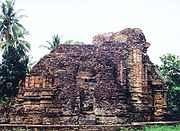
The area of Chaiya Surat Thani Thailand was already inhabited in prehistoric times by Semang and Malayan tribes. Founded in the 3rd century, until the 13th century the Srivijaya kingdom dominated the Malay Peninsula and much of the island of Java from there. The city Chaiya the name might be derived from its original Malay name "Cahaya" (means 'light', 'gleam', or 'glow'). However some scholars state that Chai-ya came from Sri-vi-ja-ya. It was a regional capital in the Srivijaya kingdom of the 5th to 13th century. Some Thai historians even claim that it was the capital of the kingdom itself for some time, but this is generally disputed. Wiang Sa and Phunphin were another main settlement of that time.
At some point in the 7th century, Cham ports in eastern Indochina started to attract traders. This diverted the flow of trade from Srivijaya. In an effort to divert the flow, the Srivijayan king or maharaja, Dharmasetu, launched various raids against the coastal cities of Indochina. The city of Indrapura by the Mekong River was temporarily controlled from Palembang in the early 8th century.[16] The Srivijayans continued to dominate areas around present-day Cambodia until the Khmer King Jayavarman II, the founder of the Khmer Empire dynasty, severed the Srivijayan link later in the same century.[18] After Dharmasetu, Samaratungga became the next Maharaja of Srivijaya. He reigned as ruler from 792 to 835. Unlike the expansionist Dharmasetu, Samaratungga did not indulge in military expansion but preferred to strengthen the Srivijayan hold of Java. He personally oversaw the construction of Borobudur; the temple was completed in 825, during his reign.[19]
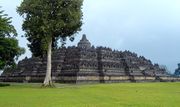
Vajrayana Buddhism
| History of Malaysia | |
|---|---|
This article is part of a series |
|
| Prehistoric Malaysia | |
| Early kingdoms | |
| Gangga Negara (2nd–11th) | |
| Langkasuka (2nd–14th) | |
| Pan Pan (3rd–5th) | |
| Srivijaya (7th–13th) | |
| Majapahit (13th-15th) | |
| The rise of Muslim states | |
| Kedah Sultanate (1136–present) | |
| Malacca Sultanate (1402–1511) | |
| Sulu Sultanate (1450–1899) | |
| Johor Sultanate (1528–present) | |
| Colonial era | |
| Portuguese Malacca (1511-1641) | |
| Dutch Malacca (1641-1824) | |
| Straits Settlements (1826–1946) | |
| British Malaya (1874–1946) | |
| Federated Malay States (1895–1946) | |
| Unfederated Malay States (1909–1946) | |
| Kingdom of Sarawak (1841–1946) | |
| North Borneo (1882–1963) | |
| Japanese occupation (1941–1945) | |
| Malaysia in transition | |
| Malayan Union (1946–1948) | |
| Federation of Malaya (1948–1963) | |
| Independence (1957) | |
| Federation of Malaysia (1963–present) | |
|
Malaysia Portal |
A stronghold of Vajrayana Buddhism, Srivijaya attracted pilgrims and scholars from other parts of Asia. These included the Chinese monk Yijing, who made several lengthy visits to Sumatra on his way to study at Nalanda University in India in 671 and 695, and the 11th century Bengali Buddhist scholar Atisha, who played a major role in the development of Vajrayana Buddhism in Tibet. Yijing reports that the kingdom was home to more than a thousand Buddhist scholars; it was in Srivijaya that he wrote his memoir of Buddhism during his own lifetime. Travellers to these islands mentioned that gold coinage was in use on the coasts, but not inland.
Relationship with regional powers

Although historical records and archaeological evidence are scarce, it appears that by the seventh century, Srivijaya had established suzerainty over large areas of Sumatra, western Java and much of the Malay Peninsula. Dominating the Malacca and Sunda straits, Srivijaya controlled both the spice route traffic and local trade, charging a toll on passing ships. Serving as an entrepôt for Chinese, Malay, and Indian markets, the port of Palembang, accessible from the coast by way of a river, accumulated great wealth. Envoys travelled to and from China frequently.
Malayu kingdom was the first rival power centre absorbed into the empire, and thus began the domination of the region through trade and conquest in the 7th and 9th centuries. Malayu kingdom's gold mines up in Batang Hari river hinterland were a crucial economic resource and may be the origin of the word Suvarnadvipa (island of gold), the Sanskrit name for Sumatra. Srivijaya helped spread the Malay culture throughout Sumatra, the Malay Peninsula, and western Borneo. Srivijaya's influence waned in the 11th century. It was in frequent conflict with, and ultimately subjugated by, Javanese kingdoms, first Singhasari and then Majapahit. This was not the first time the Srivijayans conflicted with the Javanese. According to historian Paul Michel Munoz, the Javanese Sanjaya dynasty was a strong rival of the Srivijayans in the 8th century when the Srivijayan capital was located in Java. The seat of the empire moved to Malayu Muaro Jambi in the last centuries of Srivijaya's existence.
The Khmer Empire might also have been a tributary in its early stages.
Some historians claim that Chaiya in the Surat Thani province in Southern Thailand was at least temporarily the capital of Srivijaya, but this claim is widely disputed. However, Chaiya was probably a regional centre of the kingdom. The temple of Borom That in Chaiya contains a reconstructed pagoda in Srivijaya style[20].
Phra Boromathat Chaiya is highlighted by the chedi in Srivijaya style, dating back from the 7th century but elaborately restored. Buddha relics are enshrined in the chedi, in the surrounding chapels are several Buddha statues in Srivijaya style as it was labeled by Prince Damrong in his Collected Inscriptions of Siam, is now attributed to Wat Hua Wiang in Chaiya. Dated to the year 697 of the Mahasakkarat era (i.e. 775 CE), the inscription on a Bai Sema shaped stone tells about the King of Srivijaya having erected three stupas at that site that possibly the one at Wat Phra Borom That. But also be assumed as three stupas at Wat Hua Wiang (Hua Wiang temple), Wat Lhong (Lhong temple) and Wat Kaew (Kaew temple) found in the area of Chaiya ancient city, stand in the direction from north to south on the old sand dune.
After the fall of the Srivijaya in Chaiya, the area was divided into the cities (Mueang) Chaiya, Thatong (now Kanchanadit) and Khirirat Nikhom.
Srivijaya also maintained close relations with the Pala Empire in Bengal, and an 860 inscription records that maharaja Balaputra dedicated a monastery at the Nalanda university in Pala territory. Relations with the Chola dynasty of southern India were initially friendly but deteriorated into actual warfare in the eleventh century.
Golden age
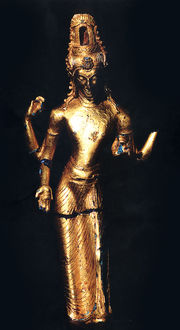
After trade disruption at Canton between 820 and 850, the ruler of Jambi (Melayu Kingdom) was able to assert enough independence to send missions to China in 853 and 871. Melayu kingdom's independence coincided with the troubled time when the Sailendran Balaputradewa, expelled from Java, seized the throne of Srivijaya. The new maharaja was able to dispatch a tributary mission to China by 902. Only two years later, the expiring Tang Dynasty conferred a title on a Srivijayan envoy.
In the first half of the tenth century, between the fall of Tang and the rise of Song, there was brisk trade between the overseas world and the Fujian kingdom of Min and the rich Guangdong kingdom of Nan Han. Srivijaya undoubtedly benefited from this, in anticipation of the prosperity it was to enjoy under the early Song. Circa 903, the Muslim writer Ibn Rustah was so impressed with the wealth of Srivijaya's ruler that he declared one would not hear of a king who was richer, stronger or with more revenue. The main urban centres were at Palembang (especially the Bukit Seguntang area), Muara Jambi and Kedah.
The migration to Madagascar accelerated in the 9th century, when the powerful Sumatran empire of Srivijaya controlled much of the maritime trade in the Indian Ocean.[12]
In late 10th century the rivalry between Sumatran Srivijaya and Javanese Medang kingdom has become more intense and hostile. The animosity was probably caused by Srivijaya effort to reclaim Sailendra lands in Java, as Balaputra and his offsprings — the series Srivijaya Maharajas — was belongs to Sailendra dynasty, or probably led by Medang aspiration to challenge Srivijaya domination in the region. In the year 990, king Dharmawangsa launched a naval invasion against Srivijaya, and unsuccessfully attempted to capture Palembang. Dharmawangsa's invasion has led the Maharaja of Srivijaya, Chulamaniwarmadewa to seeks protection from China. In 1006, Srivijaya's mandala alliance has proven its resilience by succeeds to repelled the Javanese invasion. In retaliation, Srivijaya assisted Haji (king) Wurawari of Lwaram to revolt, attacked and destroyed the Medang palace. With the death of Dharmawangsa and the fall of the Medang capital, Srivijaya has contributed to the collapse of Medang kingdom, leaving Eastern Java in further unrest, violence, and desolation for several years to come.
The influence of the empire had reached Manila by the 10th century. A kingdom under its sphere of influence had already been established there.[21][22]
By the twelfth century, the kingdom included parts of Sumatra, the Malay Peninsula, Western Java, Sulawesi, the Moluccas, Borneo and the Philippines, most notably the Sulu Archipelago and the Visayas islands (and indeed the latter island group, as well as its population, is named after the empire).[23]
Srivijaya remained a formidable sea power until the thirteenth century.[1]
Decline
In 1025, Rajendra Chola, the Chola king from Coromandel in South India, conquered Kedah from Srivijaya and occupied it for some time. The Cholas continued a series of raids and conquests throughout what is now Indonesia and Malaysia for the next 20 years. Although the Chola invasion was ultimately unsuccessful, it gravely weakened the Srivijayan hegemony and enabled the formation of regional kingdoms based, like Kediri, on intensive agriculture rather than coastal and long-distance trade.
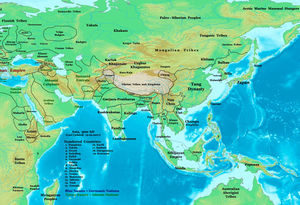
Between 1079 and 1088, Chinese records show that Srivijaya sent ambassadors from Jambi and Palembang.[24] In 1079 in particular, an ambassador from Jambi and Palembang each visited China. Jambi sent two more ambassadors to China in 1082 and 1088.[24] This suggests that the centre of Srivijaya frequently shifted between the two major cities during that period.[24] The Chola expedition as well as changing trade routes weakened Palembang, allowing Jambi to take the leadership of Srivijaya from the 11th century on.[25]
According to a Chinese source in the book of Chu-fan-chi[26] written around 1178, Chou-Ju-Kua describe that in Southeast Asia archipelago there was two most powerful and richest kingdoms; Srivijaya and Java (Kediri). In Java he founds that the people adhere two kinds of religions: Buddhism and the religions of Brahmins (Hinduism), while the people of Srivijaya adhere Buddhism. The people of Java are brave and short tempered, dare to put a fight. Their favourite pastimes was cockfighting and pig fighting. The currency was made from the mixture of copper, silver, and tin.
The book of Chu-fan-chi mentioned that Java was ruled by a maharaja, that rules several colonies: Pai-hua-yuan (Pacitan), Ma-tung (Medang), Ta-pen (Tumapel, now Malang), Hi-ning (Dieng), Jung-ya-lu (Hujung Galuh, now Surabaya), Tung-ki (Jenggi, West Papua), Ta-kang (Sumba), Huang-ma-chu (Southwest Papua), Ma-li (Bali), Kulun (Gurun, identified as Gorong or Sorong in West Papua or an island in Nusa Tenggara), Tan-jung-wu-lo (Tanjungpura in Borneo), Ti-wu (Timor), Pingya-i (Banggai in Sulawesi), and Wu-nu-ku (Maluku).
About Srivijaya, Chou-Ju-Kua[27] reported that Srivijaya had 15 colonies and was still the mightiest and wealthiest state in western part of archipelago. Srivijaya's colony are: Pong-fong (Pahang), Tong-ya-nong (Terengganu), Ling-ya-si-kia (Langkasuka), Kilan-tan (Kelantan), Fo-lo-an (Dungun, eastern part of Malay Peninsula, a town within state of Terengganu), Ji-lo-t'ing (Cherating), Ts'ien-mai (Semawe, Malay Peninsula), Pa-t'a (Sungai Paka, northern part of Malay Peninsula), Tan-ma-ling (Tambralinga, Ligor or Nakhon Si Thammarat, South Thailand), Kia-lo-hi (Grahi, northern part of Malay peninsula), Pa-lin-fong (Palembang), Sin-t'o (Sunda), Lan-wu-li (Lamuri at Aceh), Kien-pi (Jambi) and Si-lan (Cambodia)[20][28].
According to this source in early 13th century Srivijaya still ruled Sumatra, Malay peninsula, and western Java (Sunda). About Sunda, the book describe it further that the port of Sunda (Sunda Kelapa) is really good and strategic, pepper from Sunda is among the best quality. People work on agriculture and their house are build on wooden piles (rumah panggung). However the country was invested by robbers and thieves. In sum, this Chinese source from early 13th century suggested that the Indonesian archipelago was ruled by two great kingdoms, western part was under Srivijaya's rule, while eastern part was under Kediri domination.
In 1288, Singhasari, the successor of Kediri in Java, conquered Melayu state includes Palembang, Jambi as well as much of Srivijaya during the Pamalayu expedition.
In the year 1293, Majapahit ruled much of Sumatra as the successor of Singhasari. Prince Adityawarman was given responsibilities over Sumatera in 1347 by Tribhuwana Wijayatunggadewi, the third monarch of Majapahit. The rebellion in 1377 was squashed by Majapahit but it left the area of southern Sumatera in chaos and desolation.
In the following years, sedimentation on the Musi river estuary cut the kingdom's capital off from direct sea access. The strategic disadvantage crippled the trade in the Kingdom's capital. As the decline continued, Islam made its way to the Aceh region of Sumatra, spreading through contacts with Arab and Indian traders. By the late 13th century, the kingdom of Pasai in northern Sumatra converted to Islam. At the same time, Srivijaya was briefly a tributary state of the Khmer empire and later the Sukhothai kingdom. The last inscription, on which a crown prince, Ananggavarman, son of Adityawarman, is mentioned, dates from 1374.
Several attempts to revive Srivijaya were made by the fleeing princes of Srivijaya. In 1324, a prince of Srivijaya origin, Sri Maharaja Sang Utama Parameswara Batara Sri Tribuwana (Sang Nila Utama) founded the ancient Singapore (Temasek). He maintained control over Temasek for 48 years. Confirmed as ruler over Temasek by an envoy of the Chinese Emperor ca 1366. He was succeeded by his son Paduka Sri Pekerma Wira Diraja (1372–1386) and grandson, Paduka Seri Rana Wira Kerma (1386–1399). In 1401, his great grandson, Paduka Sri Maharaja Parameswara was expelled from Temasek by a Majapahit invasion. He later headed north and founded Sultanate of Malacca in 1402[29]. The Sultanate of Malacca succeeded Srivijaya Empire as a Malay political entity of the archipelago.[30][31]
Commerce
In the world of commerce, Srivijaya rapidly rose to be a far-flung empire controlling the two passages between India and China, namely the Sunda Strait from Palembang and the Malacca straits from Kedah. Arab accounts state that the empire of the maharaja was so vast that in two years the swiftest vessel could not travel round all its islands, which produced camphor, aloes, cloves, sandal-wood, nutmegs, cardamom and crubebs, ivory, gold and tin, making the maharaja as rich as any king in the Indies.
Legacy
Although Srivijaya left few archaeological remains and was almost forgotten in the collective memory of the Malay people, the rediscovery of this ancient maritime empire by Coedès back in the 1920s stimulated the notion that it was possible in the past for a widespread political entity to thrive in Southeast Asia.
According to the Malay Annals, Parameswara the founder of Malacca Sultanate claimed to be the member of the Palembang Srivijaya lineage. This suggested that in the 15th century the prestige of Srivijaya still remained and was used as the source for political legitimacy in the region.
Modern Indonesian nationalists have also invoked Srivijaya along with Majapahit, as a source of pride in Indonesia's past greatness.[32] Srivijaya has become the focus of national pride and regional identity, especially for the people of Palembang, South Sumatra province, and the Malay people as a whole. For the people of Palembang, Srivijaya has also become a source of artistic inspiration for Gending Sriwijaya song and traditional dance. The same situation also happened in southern Thailand, where Sevichai (Srivijaya) dance was recreated in accordance with the art and culture of ancient Srivijaya.
In Indonesia, Srivijaya is a street name in many cities and has become synonymous with Palembang and South Sumatra. Srivijaya University, established in 1960 in Palembang, was named after Srivijaya. Kodam Sriwijaya (a military commando area unit), PT Pupuk Sriwijaya (a fertilizer company), Sriwijaya Post (a Palembang based newspaper), Sriwijaya Air (an airline), Gelora Sriwijaya Stadium, and Sriwijaya F.C. (Palembang football club) were also all named to honor this ancient maritime empire.
List of Rulers
| History of Thailand |
|---|
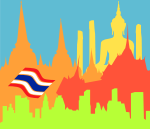 |
| Prehistory |
| Early history |
|
Initial states
Legendary
Suvarnabhumi Central Thailand Dvaravati Lavo Supannabhum Northern Thailand Singhanavati Ngoenyang Hariphunchai Southern Thailand Pan Pan Raktamaritika Langkasuka Srivijaya Tambralinga Nakhon Si Thammarat |
| History |
| Sukhothai Kingdom Ayutthaya Kingdom Thonburi Kingdom Rattanakosin Kingdom History from 1932-1973 History since 1973 |
|
Regional history
Isan
Lanna Phitsanulok Bangkok |
|
Related topics
|
|
Recent history
2005-2006 Political crisis
2006 Coup d'état |
The Maharajas of Srivijaya[20][33]
| Date | King's name | Capital | Stone inscription or embassies to China and events |
|---|---|---|---|
| 683 | Dapunta Hyang Sri Jayanasa | Srivijaya | Kedukan Bukit (682), Talang Tuo (684), and Kota Kapur inscriptions
Malayu conquest, Central Java conquest |
| 702 | Indravarman
Che-li-to-le-pa-mo |
Srivijaya
Shih-li-fo-shih |
Embassies 702-716, 724(China)
Embassies to Caliph Muawiyah I and Caliph Umar bin Abdul Aziz |
| 728 | Rudra vikraman
Lieou-t'eng-wei-kong |
Srivijaya
Shih-li-fo-shih |
Embassy 728-748 |
| No information for the period 728-775 | |||
| 790 | Dharmasetu or Vishnu | Java | Nakhon Si Thammarat (Ligor), Vat Sema Muang |
| 775 | Dharanindra | Java | Ligor, started to build Borobudur in 770,
conquered South Cambodia |
| 782 | Samaragrawira | Java | Ligor, Arabian text (790), started to build Borobudur in 770, conquered South Cambodia |
| 792 | Samaratungga | Java | 802 lost Cambodia, 825 completion of Borobudur |
| 835 | Balaputradewa | Srivijaya
San-fo-ts'i |
Lost central Java, moved to Srivijaya
Nalanda Inscription (860) |
| No information for the period 835-960 | |||
| 960 | Çri Udayadityavarman
Se-li-hou-ta-hia-li-tan |
Srivijaya
San-fo-ts'i |
Embassies 960, 962 |
| 980 | Haji
Hia-Tche |
Srivijaya
San-fo-ts'i |
Embassies 980-983 |
| 988 | Sri Culamanivarmadeva
Se-li-chu-la-wu-ni-fu-ma-tian-hwa |
Srivijaya
San-fo-ts'i |
Embassy 988-992-1003
Javanese attack of Srivijaya, building of temple for Chinese Emperor, Tanjore Inscription or Leiden Inscription (1044), gift of village by Raja-raja I |
| 1008 | Sri Maravijayottungga
Se-li-ma-la-pi |
Srivijaya
San-fo-ts'i |
Embassy 1008 |
| 1017 | Sumatrabhumi | Srivijaya
San-fo-ts'i |
Embassy 1017 |
| 1025 | Sangramavijayottungga | Srivijaya
San-fo-ts'i |
Captured by Rajendra Chola
Chola Inscription on the temple of Rajaraja, Tanjore |
| 1028 | Sri Deva | Palembang
Pa-lin-fong |
Embassy 1028
Building of Tien Ching temple, Kuang Cho (Kanton) for Chinese Emperor |
| 1078 | Kulothunga Chola I
Ti-hua-ka-lo |
Palembang
Pa-lin-fong |
Embassy 1079 |
| No information for the period 1080-1155 | |||
| 1156 | Rajaraja Chola II | Palembang
Pa-lin-fong |
Larger Leyden Plates |
| 1183 | Srimat Trailokyaraja Maulibhusana Warmadewa | Dharmasraya Kingdom | Bronze Buddha Chaiya 1183 |
| No information for the period 1183-1275 | |||
| 1286 | Srimat Tribhuwanaraja Mauli Warmadewa | Dharmasraya Kingdom | Padang Roco Inscription 1286, Pamalayu expedition 1275-1293 |
References
- ↑ 1.0 1.1 1.2 Munoz, Paul Michel (2006). Early Kingdoms of the Indonesian Archipelago and the Malay Peninsula. Singapore: Editions Didier Millet. pp. 171. ISBN 9814155675.
- ↑ Munoz. Early Kingdoms. pp. 122.
- ↑ Zain, Sabri. "Sejarah Melayu, Buddhist Empires". http://www.sabrizain.org/malaya/hindu.htm.
- ↑ Peter Bellwood, James J. Fox, Darrell Tryon (1995). "The Austronesians: Historical and Comparative Perspectives". http://epress.anu.edu.au/austronesians/austronesians/mobile_devices/ch15s05.html.
- ↑ 5.0 5.1 5.2 Munoz. Early Kingdoms. pp. 117.
- ↑ 6.0 6.1 Taylor, Jean Gelman (2003). Indonesia: Peoples and Histories. New Haven and London: Yale University Press. pp. 8–9. ISBN 0-300-10518-5.
- ↑ Krom, N.J. (1938). "Het Hindoe-tijdperk". In F.W. Stapel. Geschiedenis van Nederlandsch Indië. Amsterdam: N.V. U.M. Joost van den Vondel. vol. I p. 149.
- ↑ 8.0 8.1 8.2 8.3 Munoz. Early Kingdoms. pp. 114.
- ↑ Munoz. Early Kingdoms. pp. 102.
- ↑ Krom, N.J. (1943). Het oude Java en zijn kunst (2nd ed. ed.). Haarlem: Erven F. Bohn N.V.. pp. 12.
- ↑ Taylor. Indonesia. pp. 29.
- ↑ 12.0 12.1 "History of Madagascar". Lonely Planet.com. http://www.lonelyplanet.com/madagascar/history. Retrieved 2010-07-07.
- ↑ Munoz. Early Kingdoms. pp. 113.
- ↑ Munoz. Early Kingdoms. pp. 124.
- ↑ Munoz. Early Kingdoms. pp. 125.
- ↑ 16.0 16.1 Munoz. Early Kingdoms. pp. 132.
- ↑ Munoz. Early Kingdoms. pp. 130.
- ↑ Munoz. Early Kingdoms. pp. 140.
- ↑ Munoz. Early Kingdoms. pp. 143.
- ↑ 20.0 20.1 20.2 Muljana, Slamet (2006). Sriwijaya. Yogyakarta: LKiS. ISBN 9798451627.
- ↑ Laguna Copperplate Inscription - Article in English
- ↑ The Laguna Copperplate Inscription. Accessed September 04, 2008.
- ↑ Rasul, Jainal D. (2003). Agonies and Dreams: The Filipino Muslims and Other Minorities". Quezon City: CARE Minorities. pp. 77.
- ↑ 24.0 24.1 24.2 Munoz. Early Kingdoms. pp. 165.
- ↑ Munoz. Early Kingdoms. pp. 167.
- ↑ Friedrich Hirth and W.W.Rockhill Chao Ju-kua, His Work on the Chinese and Arab Trade in the Twelfth and Thirteen centuries, entitled Chu-fan-chi St Petersburg,1911.
- ↑ Friedrich Hirth and W.W.Rockhill, (1911), Chao Ju-kua, His Work on the Chinese and Arab Trade in the Twelfth and Thirteen centuries, entitled Chu-fan-chi, St Petersburg.
- ↑ Drs. R. Soekmono, (1973, 5th reprint edition in 1988). Pengantar Sejarah Kebudayaan Indonesia 2, 2nd ed.. Yogyakarta: Penerbit Kanisius. pp. 60.
- ↑ Buyers, Christopher. "The Ruling House of Malacca - Johor". http://www.royalark.net/Malaysia/malacca.htm. Retrieved 2009-06-13.
- ↑ Alexanderll, James (September 2006). Malaysia Brunei & Singapore. New Holland Publishers. pp. 8. ISBN 1860113095, 9781860113093.
- ↑ "South and Southeast Asia, 500 - 1500". The Encyclopedia of World History. 1. Houghton Mifflin Harcourt. 2001. pp. 138.
- ↑ Centrality: Indonesia's changing role in ASEAN
- ↑ Munoz. Early Kingdoms. pp. 175.
Further references
- D. G. E. Hall, A History of South-east Asia. London: Macmillan, 1955.
- D. R. SarDesai. Southeast Asia: Past and Present. Boulder: Westview Press, 1997.
- Lynda Norene Shaffer. Maritime Southeast Asia to 1500. London: ME Sharpe Armonk, 1996.
- Stuart-Fox, Martin. A Short History of China and Southeast Asia: Tribute, Trade, and Influence. London: Allen and Unwin, 2003.
- Munoz, Paul Michel (2006). Early Kingdoms of the Indonesian Archipelago and the Malay Peninsula. Editions Didier Millet. ISBN 9814155675.
- Muljana, Slamet (2006). Sriwijaya. Yogyakarta: LKiS. ISBN 9798451627.
External links
- Review of Srivijaya resources on the Internet - but many are dead links
- Review of the origin of Melayu dialectics based on Srivijayan Inscriptions; site in Indonesian on Old Malay
- Timeline of Indonesia from prehistory to present: click on the period for info
- Melayu online: Kerajaan Sriwijaya
- Journey to the past: Candi Muaro Jambi
- Candi Muaro Jambi
- Chaiya National Museum
- Surat Thani Province,Thailand
